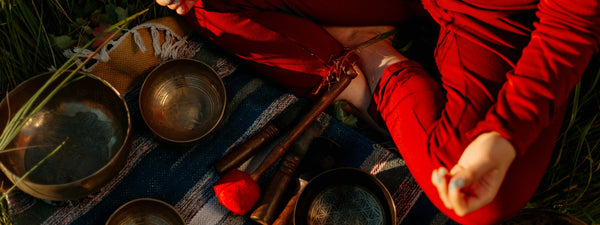International Sleep Cultures: Embracing the Night Around the Globe
•Posted on March 12 2024

Whether you enjoy curling up under the covers at the end of a long day or feel that sleep is for the weak. Sleep is an important part of our day and even our culture in some instances. From dream mythology to bedtime rituals, each corner of the world has a unique relationship with the sandman and the nightly voyage into dreams. Once again, I have gone on a little tangent and thought I would drag you, kicking and screaming, with me. Grab a cup of tea or glass of wine and let’s explore the diverse sleep cultures that span the globe.
- Japan: The Art of a sneaky nap.
In Japan, sleep isn't just a biological necessity; it's an art form. The concept of "inemuri," or napping in public, is widely accepted and often seen as a sign of hard work. The Japanese embrace the art of sleep, in various ways, from futons on tatami mats to high-tech gadgets designed to enhance the sleep experience.

- Sweden: Cozy Comforts of "Hygge"
The Scandinavian embrace of "hygge" (say that 5 times fast) extends to bedtime rituals. In Sweden, a good night's sleep is achieved through a combination of comfort and coziness. From layered blankets to the soothing glow of candles, Swedes create a sleep environment that exudes warmth and tranquillity.

- India: Ayurvedic Insights
In India, the ancient science of Ayurveda has significantly influenced sleep culture. Ayurveda emphasizes the balance of mind and body, promoting practices like meditation and herbal remedies to enhance sleep quality. Traditional Indian sleep attire, like loose cotton garments, reflects the importance of comfort in the quest for a restful night.

- Spain: The Siesta Tradition
Spain's midday siesta isn't just a nap; it's a cultural institution. Spaniards embrace the afternoon pause to recharge and escape the heat. The siesta reflects a pragmatic approach to energy conservation, ensuring people are refreshed for the evening ahead. Not sure why we have yet to adopt this method in African countries.

- Nigeria: Dream Beliefs and Cultural Significance
In Nigeria, sleep holds cultural and spiritual significance. Dreams are often considered messages from the ancestors or divine beings, and interpretations play a crucial role in decision-making. Sleep is a bridge connecting the waking world to the realm of the sacred. I would not do well in Nigeria as I can never remember my dreams, I think I would be crippled with indecision.

- Native American Tribes: Dream Catcher Traditions
Many Native American tribes incorporate dream catchers into their sleep culture. These intricate hoops, adorned with feathers and beads, are believed to filter out bad dreams and allow only positive visions to enter the dreamer's mind. This cultural practice emphasizes the importance of a peaceful night's sleep.

- Iceland: Midnight Sun Challenges
In the land of the midnight sun, Icelanders face unique challenges in maintaining healthy sleep patterns. During the extended daylight of summer, blackout curtains become a necessity to create a semblance of nighttime. Conversely, in the darkness of winter, the northern lights add a magical touch to the sleep experience. Interestingly Iceland has been voted the number 2 on the Happiness Scale index.

- Brazil: The Joy of Shared Beds, head out of the gutter please.
In Brazil, the act of sharing a bed is not limited to umm romantic partners. Family members often share sleeping spaces, fostering a sense of connection and emotional warmth. The emphasis is on togetherness, turning sleep into a communal experience. I feel my cats may think they are Brazilian.

- Italy: The bedroom ritual.
The Italian do so many things right, pizza, pasta, gelato even sleep. They focus on a serene bedroom environment. Making the bed daily, I did not realise this was unusual, having a calming colour palate all attribute to a peaceful sleep.

- Morocco: Polly put the kettle on.
Mint tea in the evening is a common ritual in Moroccan bedtimes. The ritual is believed to promote relaxation and can be associated with the process of winding down before bedtime.

As we traverse these diverse sleep cultures, one common thread emerges – the universal need for rest and rejuvenation. Whether influenced by ancient traditions or modern innovations, the ways in which different cultures approach sleep provide a rich tapestry of practices, each contributing to the global mosaic of our shared nighttime journey.
In an effort to make this blog brief I have left out several interesting facts from other countries. Leave a comment if you have any thing to add.
Lots of love,
Kim
References
Photo by ABDELMOUGHIT LAHBABI: https://www.pexels.com/photo/tea-room-moorish-decor-in-medina-7391598/
Photo by Anna Shvets: https://www.pexels.com/photo/family-reading-a-book-together-4586629/
Photo by Simon Migaj: https://www.pexels.com/photo/water-falls-1009136/
Photo by Santiago Permana: https://www.pexels.com/photo/hanging-dreamcatcher-at-the-market-11719332/
Photo by Awaji-Tono Etex: https://www.pexels.com/photo/woman-standing-near-white-ship-3482711/
Photo by AXP Photography: https://www.pexels.com/photo/colorful-ornamented-wall-in-seville-16549997/
Photo by cottonbro studio: https://www.pexels.com/photo/person-in-red-long-sleeve-shirt-holding-brown-wooden-handle-5416013/
Photo by cottonbro studio: https://www.pexels.com/photo/stack-of-books-on-bedside-table-7097187/
Photo by Yaroslav Shuraev: https://www.pexels.com/photo/woman-sleeping-in-front-of-sewing-machine-8516197/
More Posts
-
The Slippery Histor...
Ever pondered the bubbly bar of soap in your shower? From the ancient Babylonians' gritty concoctions to luxurious artisanal creations, soap has a ...
Read More -
International Sleep...
"International Sleep Cultures: Embracing the Night Around the Globe" In this exploration of sleep cultures worldwide, the blog takes readers on a c...
Read More -
The History of Slee...
Ever wondered about the story behind sleep masks? Before brushing them off, consider this brief journey. In the 19th century, electric lights disru...
Read More



Comments
0 Comments
Leave a Comment